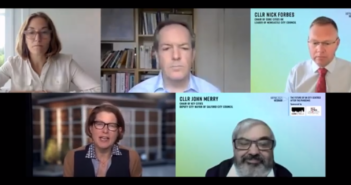Recently there have been numerous stories on the impact of driverless cars. For example, “A Driverless Future Threatens the Laws of Real Estate: It may no longer be about ‘location, location, location’”[1]. While driverless cars will change many industries and improve productivity, they will not change the principles of urban economics nor cause the death of distance. Nor will they eliminate the need for adding roads as the population grows.
It’s true that the design of cars will change and owning cars will become less important. Cars will come in versions that are better for sleeping, working, watching videos or conference calling. Many deliveries will occur without drivers and this will allow us to be more productive. Even truck drivers that embrace the technology and survive the reduction in the number of drivers, will be more productive as they are able to cover longer distances faster. But the economic laws based on the need for less time and quicker access will still matter enough that we will not simply melt into a homogeneous plane of development with urban and suburban areas become indistinguishable.
The laws of demand versus cost will also come into play. When the cost of transport goes down (lower fuel costs and more productive time when in a vehicle) we will consume more of it. We will do this by spreading out further, but we will also do this in other ways. For example, if I am in a meeting of uncertain duration away from my home office, I may request my vehicle to go into “hover mode” where it circles the area near my meetings and stays available on a moment’s notice. The reason I can do this is because the cost of running it in circles is so low. If others also want quick access and request their vehicles go into hover mode, the streets, in lieu of parking lots, could quickly fill up. This will require cities to impose fees on empty vehicles awaiting riders or else gridlock would quickly ensue. Some buildings will change their designs to accommodate more vehicles in waiting. Landlords will eliminate some indoor parking but not all of it, and we will need far more access drop-off-lanes built into nearly all site plans. Designs and urban forms will change, but not the laws of economics or importance of real estate location decisions.
TESLA is often cited as one driver of these changes but TESLA’s long-term success will probably be as much a result of their real estate decisions as their batteries and great vehicles. They are the only car maker actively expanding super charger locations all over the US. We have about 115,000 gas stations in the US, but this tiny automaker already has over 5000 superchargers in some 800 plus locations and continues to add more on a daily basis. Smart office campuses, hotels and wineries have joined in providing space for these Superchargers.
Location still matters a great deal, as do real estate strategies.[2] The importance of location may be less for some uses, but it will be higher for others. It’s not as easy as simply reducing density. We need to think more carefully about how driverless cars will really change the landscape. The death of distance will not happen anytime soon.
[1] See this article by Jack Sidders and Jess Shankleman, Feb. 6, 2018, at https://www.bloomberg.com/news/articles/2018-02-06/a-driverless-future-threatens-the-laws-of-real-estate
[2] Right now, the Chinese have been buying up access to cobalt and lithium mines all over the world, another smart real estate play.
Top photo © chombosan/GettyImages



